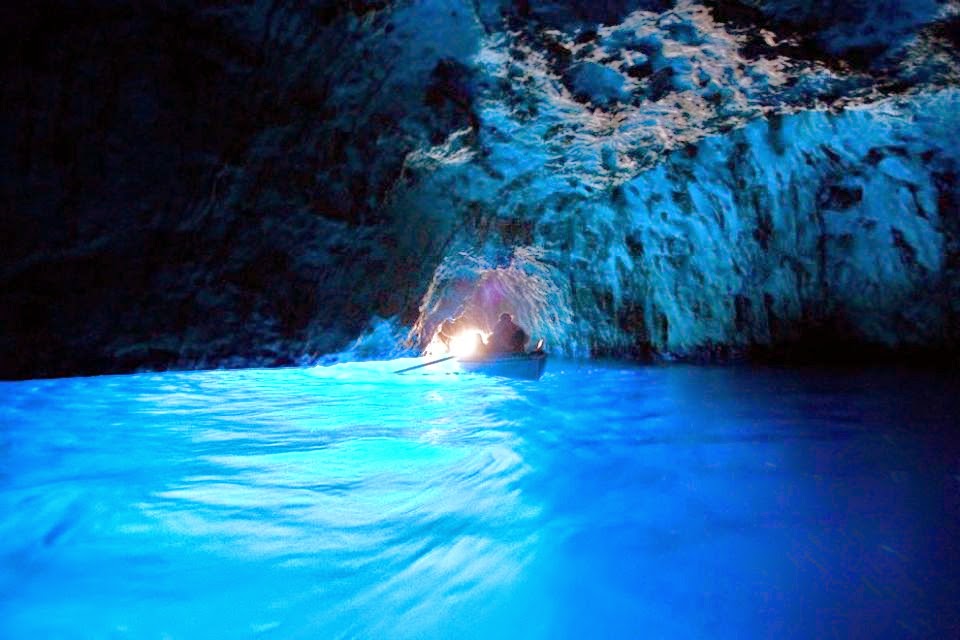Other colors are absorbed in the water and only blue light reaches the interior of the cave. As a result whole 54 m long and up to 15 m deep cave is illuminated with a mysterious, phosphorescent blue light. Visitors to the cave are illuminated from below, and if one puts his hand in the water, the skin is glowing eerily. One more interesting feature is sulphur springs at the bottom of cave – thanks to this the cave is very rich with marine life.
Once upon a time, or the 1st century A.D., Roman Emperor Tiberius retired to the Isle of Capri, Italy, and used this beautiful Blue Grotto, a sea cave, as his personal swimming pool. Emperor Tiberius loved the Blue Grotto so much that it was his favorite nymphaeum, a temple dedicated to sea nymphs…also described as a sanctuary for water nymphs.
Blue waters of Grotta Azzurra seem to glow, but the illumination was considered eerie for centuries after Tiberius. The Blue Grotto, known as Gradola long ago to locals, was abandoned and “feared by local sailors because of legends of spirits and demons which inhabited the cave.” But in 1826, the cave was “rediscovered” by German poet and painter August Kopisch and his friend, painter Ernst Fries. Kopisch described its extraordinary beauty in a book
There are many local legends abound about the Blue Grotto according to Savory Adventures: “Was it really the home of the Nereidi–fifty nymphs of the sea in Greek mythology, each of them personified by slow soft waves that brought that brought calm and serenity to those who entered their abodes? You be the judge. According to legend, during moonlit nights, the Nereidi danced and sang in the proximity of the coastline near Positano bay, chosen for its clear waters and excellent acoustics to echo their enchanting songs.”
The cavernous interior, known as the duomo (cathedral), rises from seven to 14 meters (46 feet); the water below is 13 meters (42.6 feet) deep. The cave has two entrances – a smaller one (1.5 m wide) at the waterline and at least ten times larger one – below the sea. A small 1 – 2 m thick barrier below the sea level divides both entrances. Thus – a little sunlight enters through the upper hole – and this bright spot of light does not allow to see the large hole below it. A lot more light enters through the enormous underwater hole.
Blue waters of Grotta Azzurra seem to glow, but the illumination was considered eerie for centuries after Tiberius. The Blue Grotto, known as Gradola long ago to locals, was abandoned and “feared by local sailors because of legends of spirits and demons which inhabited the cave.” But in 1826, the cave was “rediscovered” by German poet and painter August Kopisch and his friend, painter Ernst Fries. Kopisch described its extraordinary beauty in a book
There are many local legends abound about the Blue Grotto according to Savory Adventures: “Was it really the home of the Nereidi–fifty nymphs of the sea in Greek mythology, each of them personified by slow soft waves that brought that brought calm and serenity to those who entered their abodes? You be the judge. According to legend, during moonlit nights, the Nereidi danced and sang in the proximity of the coastline near Positano bay, chosen for its clear waters and excellent acoustics to echo their enchanting songs.”
The cavernous interior, known as the duomo (cathedral), rises from seven to 14 meters (46 feet); the water below is 13 meters (42.6 feet) deep. The cave has two entrances – a smaller one (1.5 m wide) at the waterline and at least ten times larger one – below the sea. A small 1 – 2 m thick barrier below the sea level divides both entrances. Thus – a little sunlight enters through the upper hole – and this bright spot of light does not allow to see the large hole below it. A lot more light enters through the enormous underwater hole.












